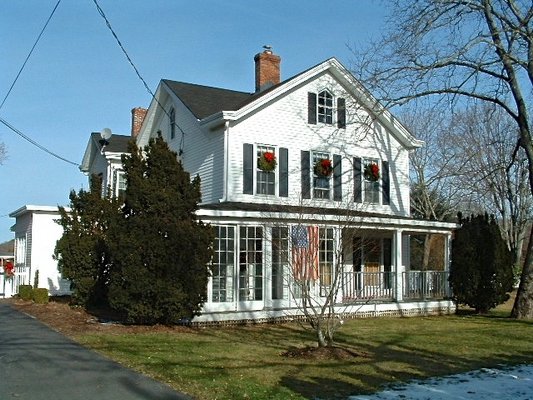
In what could be one of the most creative pieces of incentive-based legislation to come down the pike in a long time, Southampton Town is poised to make the preservation of historic houses much simpler and more appealing to property owners.Readers of this newspaper have seen too many articles over the years about one historic house after another meeting the wrecker’s ball. And when not demolished they have sometimes undergone what Ada Louise Huxtable characterized as “salvation by mutilation.” To push back the unrelenting tide of teardowns, the town passed delay-of-demolition legislation a few years ago, which requires homes 75 years of age or older to be flagged by the Building Department when a demolition application is filed. These houses are then referred to the Landmarks and Historic Districts Board for review. Occasionally, however, houses aren’t flagged and fall through the cracks with no excuses from the Building Department.
While the LHDB does not have the power to deny a demolition, it does have the wherewithal, in an advisory capacity, to make a case to property owners about the historic significance of their homes. On more than one occasion the owners decided to preserve rather than demolish or to find a way to relocate a house to another property. Still, the teardowns of potentially landmark-worthy, historically significant homes have continued unabated for the most part. The main obstacle to landmark designation for these houses has to do with the fact that owner consent is legally required.
Many property owners who buy these sites with historic houses do so just to obtain the land, as there are very few good sites left on which to build new homes. Other property owners just can’t see these historic houses as being suitable for everyday 21st-century living.
The LHBD, spearheaded by Chairwoman Sally Spanburgh, started looking at other areas around the country for ways of preserving historic structures and found regulations similar to the legislation now being proposed for Southampton. With the help of Kyle Collins and Janice Scherer in the Planning Department, the proposed amendment is tailored to encourage the preservation and landmark designation of Southampton’s historic houses.
Councilwoman Bridget Fleming, who is the liaison to the LHDB, is sponsoring the amendment to section 330-9D(4) of the Town Code to incentivize landmark designation for “carriage houses.” These so-called carriage houses, however, have nothing to do with the repositories used for the horse and buggy trade of yore. Rather, the term “carriage house,” used euphemistically in section 330-9D(4) of the code, refers to a “density incentive for two dwellings (one principal and one accessory dwelling on one lot) where one or more development right or Pine Barrens Credit is transferred to the site.
“The development right or PBC transfer,” it continues, “shall not be required when one of the two dwellings is a designated Town Landmark, pursuant to Town Code section 330-321, and the Town Board has determined to extinguish a town–owned development right in favor of the application.”
Translated into English, this means that by landmarking the existing house, a homeowner will be legally allowed to put a second dwelling (the “carriage house”) on the property. The development right is analogous to a commodity, and the property owner can apply to extinguish the town-owned development right from the town—and consequently secure the right to a second dwelling—while applying for landmark designation simultaneously.
The development right can be officially extinguished only when the house has become a designated landmark after a public hearing before the Town Board.
The amendment to the legislation also allows for flexibility in terms of how the new and old structures are designated. If the preexisting structure is converted to a guest (“carriage”) house, then it will not have to meet current dimensional regulations so long as the proposed new main house (“principal dwelling”) conforms to the required principal setbacks.
The floor area of the carriage house cannot exceed 50 percent of the principal dwelling, so if the existing house, for example, is 5,000 square feet, then the carriage house would be limited to 2,500 square feet, with a height no greater than 24 feet. The minimum lot area required to allow for both the principal dwelling and the accessory dwelling in zoning districts of three acres or greater would be three acres. In eligible zoning districts with smaller lot sizes, on the other hand, the property would have to be one and a half times the minimum lot size that is normally required.
Water supply and sewerage disposal for the two buildings must comply with the requirements of the Suffolk County Department of Health Services.
According to research done by the Planning Department, there are 114 properties potentially eligible for landmark designation under the proposed amendment.
Preservation of our historic resources is good business. Landmark designation of historic houses means that the LHBD can be a powerful advocate for homeowners who choose to seek landmark designation. When renovations take place this board can shepherd a homeowner to a Certificate of Appropriateness without the worry of a mutilation occurring. The accessory dwellings on these properties could potentially provide more affordable housing within the township as well.
For Southampton Township, the passage of this proposed amendment would be a wonderful achievement. A public hearing on the proposed amendment with a presentation by the LHBD will be held on May 27 at 6 p.m. at Southampton Town Hall, 116 Hampton Road, Southampton. The final determination on the proposed amendment will be made at another hearing later in June.
Anne Surchin is an East End architect and co-author of “Houses of the Hamptons 1880-1930.”